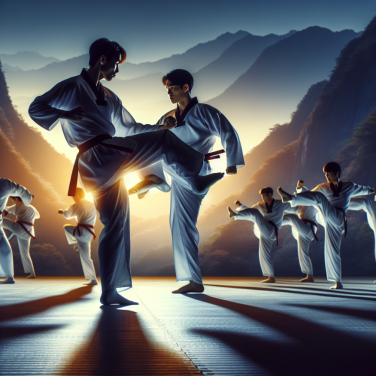Tracing the Roots of Taekkyeon: Korea's Martial Heritage
Taekkyeon, often romanized as Taekgyeon or Taekkyon, is one of Korea's oldest martial arts, with a rich history that dates back centuries. It is a traditional Korean martial art that uniquely combines dance-like movements with combat techniques. Unlike other martial arts that focus solely on striking or grappling, Taekkyeon incorporates a wide variety of techniques, including hand strikes, foot strikes, throws, and joint locks.
One of the earliest mentions of Taekkyeon can be traced back to the Joseon Dynasty (1392–1897). Historical records from this period, such as the "Jae Doo Tae Bo Bi Gyeol" (a manual on martial training), reference a martial art that closely resembles Taekkyeon's fluid and dynamic movements. The mural paintings in the royal tombs from the Goguryeo Dynasty (37 BCE–668 CE) also depict figures engaging in what appear to be martial arts practices similar to Taekkyeon.
During this time, Taekkyeon was not just a martial practice; it had cultural significance and was a part of Korea's folk games. It was particularly popular during festivals and celebrations, where it would often be performed for entertainment. In fact, the term "Taekkyeon" is believed to be derived from the words "tae" meaning "to trample" or "foot" and "kyeon" meaning "fist" or "hand," indicating the martial art's emphasis on both kicking and hand techniques.
Another distinctive aspect of Taekkyeon is its emphasis on the natural flow of movement. Practitioners are taught to move in a rhythmic and fluid manner, using the natural momentum of their bodies to execute techniques. This philosophy is closely tied with the Korean concept of 'pungmul' (풍물), which refers to the traditional Korean music and dance performed in farming communities. The flowing, circular movements in Taekkyeon are reminiscent of these dance forms and reflect a unique combination of martial skills and artistic expression, symbolizing a balance between the physical and the spiritual.
The practice of Taekkyeon diminished during the Japanese occupation of Korea (1910–1945), as the colonial government banned traditional Korean martial arts in an attempt to suppress Korean culture. However, a small number of dedicated practitioners kept the art alive, passing down their knowledge through the generations.
Read also:
Scoring Big: Exploring Crypto's Integration in Sports
The Techniques and Traditions of Taekkyeon: A Comprehensive Guide
Taekkyeon is often recognized for its fluidity and rhythmic movements, distinguishing it substantially from other martial arts which are more focused on power or direct strikes. At the heart of Taekkyeon lies a rich tapestry of techniques and traditions, deeply woven into Korea's history and culture. Together, these facets contribute to the unique identity of this ancient martial art.
Physical techniques in Taekkyeon are characterized by the extensive use of tripping and throwing opponents to the ground, following the martial art's principle of 'softness controls hardness'. This reflects the natural flowing movement and flexible postures that are emblematic of Taekkyeon. Even striking techniques, when used, are often delivered in a whipping motion, which is less about brute force and more about the precision and timing of the strike, coupled with the practitioner's agility.
Footwork in Taekkyeon is especially crucial. Practitioners dance around their opponents in a movement called 'pum balgi', which closely resembles a rhythmic and continuous flow that mimics the gentle yet powerful essence of water. This allows swift changes in direction and position, creating a challenging and constantly moving target for the opponent. Additionally, such movement helps execute trips and sweeps more effectively by off-balancing the opponent.
The combat philosophy of Taekkyeon emphasizes the concept of 'Hwa', which means harmony. Practitioners are taught to blend with the opponent's energy, redirecting it, similar to principles found in Aikido and Tai Chi. The aim is not to meet force with force, but rather to use the opponent's energy against them. This philosophy extends beyond physical confrontation and is also viewed as a guide for personal conduct in everyday life.
As for Taekkyeon's traditions, the martial art is closely tied with Korean culture, reflecting elements of the nation's music, dance, and ritual. One of the key traditional elements of Taekkyeon is its association with rituals. Historically, matches were often held during village festivals and were as much a celebration of the community and its culture as they were displays of martial prowess.
The music that accompanies Taekkyeon is also distinctive, featuring traditional Korean instruments that set the rhythm for the practitioners’ movements. This music is an integral part of the art, with the beat helping practitioners maintain their flow and timing during practice or competition.




